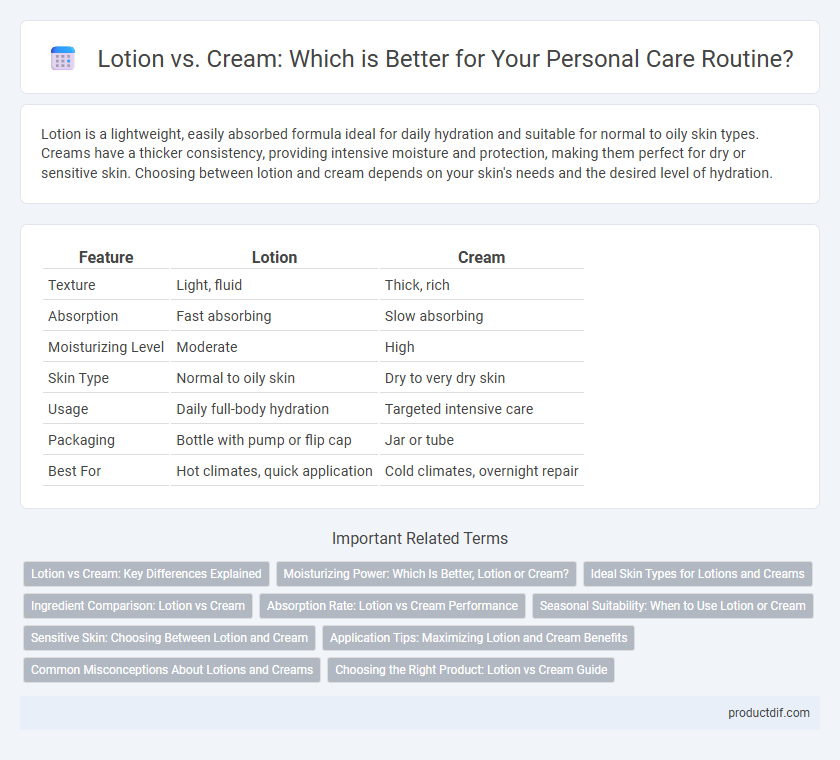Lotion is a lightweight, easily absorbed formula ideal for daily hydration and suitable for normal to oily skin types. Creams have a thicker consistency, providing intensive moisture and protection, making them perfect for dry or sensitive skin. Choosing between lotion and cream depends on your skin's needs and the desired level of hydration.
Table of Comparison
| Feature | Lotion | Cream |
|---|---|---|
| Texture | Light, fluid | Thick, rich |
| Absorption | Fast absorbing | Slow absorbing |
| Moisturizing Level | Moderate | High |
| Skin Type | Normal to oily skin | Dry to very dry skin |
| Usage | Daily full-body hydration | Targeted intensive care |
| Packaging | Bottle with pump or flip cap | Jar or tube |
| Best For | Hot climates, quick application | Cold climates, overnight repair |
Lotion vs Cream: Key Differences Explained
Lotion vs cream primarily differ in their water and oil content, where lotions have higher water content making them lighter and more suitable for oily or normal skin. Creams contain more oil, providing a thicker texture that offers intense hydration ideal for dry or mature skin types. Choosing between lotion and cream depends on skin type, desired absorption rate, and targeted moisture level requirements.
Moisturizing Power: Which Is Better, Lotion or Cream?
Creams contain a higher concentration of oils and emulsifiers than lotions, providing a thicker barrier that locks in moisture more effectively, making them ideal for very dry or sensitive skin. Lotions have a lighter consistency with more water content, allowing faster absorption but offering less intense hydration compared to creams. For sustained moisturizing power, creams outperform lotions by delivering longer-lasting protection and improved skin barrier reinforcement.
Ideal Skin Types for Lotions and Creams
Lotions are ideal for oily or combination skin due to their lightweight, fast-absorbing formula that provides hydration without clogging pores. Creams suit dry or sensitive skin as they contain higher oil content, offering intense moisture and forming a protective barrier against environmental stressors. Selecting between lotion and cream depends on skin type severity and hydration needs to maintain optimal skin health.
Ingredient Comparison: Lotion vs Cream
Lotions typically contain a higher water content and lighter oils like mineral oil or petrolatum, making them quickly absorbent and suitable for normal to oily skin. Creams have a thicker consistency with more emollients such as shea butter, beeswax, or lanolin, offering intense hydration ideal for dry or sensitive skin. The ingredient ratio in lotions favors moisture delivery with lightweight feel, while creams blend oils and water for a barrier-forming, longer-lasting moisturizing effect.
Absorption Rate: Lotion vs Cream Performance
Lotions typically have a higher absorption rate than creams due to their lighter, water-based formulation, allowing them to penetrate quickly into the skin. Creams, with their thicker, oil-based consistency, provide a slower absorption that creates a protective barrier and offers longer-lasting moisture retention. For individuals seeking fast hydration without greasiness, lotions are preferable, while creams benefit those needing intensive moisturizing and skin protection.
Seasonal Suitability: When to Use Lotion or Cream
Lotion is ideal for warm and humid seasons due to its lightweight texture and quick absorption, preventing a greasy feel on the skin. Cream suits colder, drier months as its thicker consistency provides intense hydration and seals moisture effectively. Choosing between lotion and cream based on seasonal needs ensures optimal skin hydration and comfort year-round.
Sensitive Skin: Choosing Between Lotion and Cream
For sensitive skin, selecting between lotion and cream depends on hydration needs and skin type. Creams contain a higher oil content, providing intensive moisture and forming a protective barrier ideal for very dry or irritated skin. Lotions, being lighter and more easily absorbed, suit sensitive skin prone to mild dryness or acne, offering hydration without clogging pores.
Application Tips: Maximizing Lotion and Cream Benefits
For optimal results, apply lotion on slightly damp skin to enhance absorption and lock in moisture, while creams work best on dry or rough areas for intensive hydration. Use gentle, upward strokes to prevent skin stretching and ensure even distribution of both lotion and cream. Layer thinner lotions before heavier creams to create a protective barrier and maximize skin nourishment throughout the day.
Common Misconceptions About Lotions and Creams
Lotions are often mistaken for being less moisturizing than creams, but both contain water and oils in varying ratios tailored for different skin types and conditions. Creams generally have a thicker consistency due to higher oil content, providing more intense hydration, especially for dry or sensitive skin. Misconceptions also arise regarding absorption rates; lotions typically absorb faster, making them suitable for daytime use, while creams form a protective barrier ideal for nighttime application or severely dry areas.
Choosing the Right Product: Lotion vs Cream Guide
Lotions have a lighter consistency and higher water content, making them ideal for normal to slightly dry skin and hot climates, as they absorb quickly without leaving a greasy residue. Creams contain a thicker texture and higher oil content, providing intense moisture suitable for very dry or sensitive skin, especially in cold or dry environments. Selecting the right product depends on your skin type, moisture needs, and environmental factors to ensure optimal hydration and skin protection.
lotion vs cream Infographic

 productdif.com
productdif.com